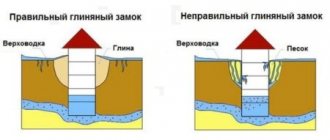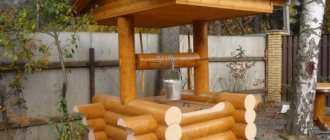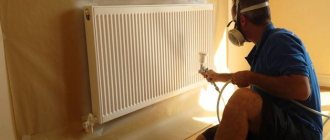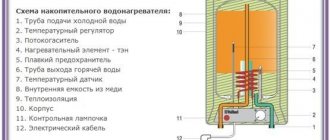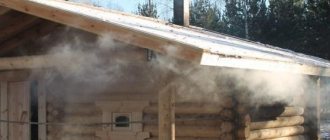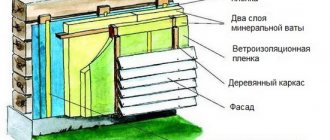Water supply
Author Oksana Knopa
Date
Jan 13, 2016
0
1 066
Share
Owners of summer cottages and private households, deprived of the opportunity to connect to the general water supply network, have no other alternative than to dig a well on their land. The problems of arranging life do not end there, because the water source needs care and protection.
- LiveJournal
- Blogger
Layout of a clay castle
- What should a well be protected from?
- What is a protective clay structure?
- Procedure for carrying out work
Why does a well need a clay castle and is it needed at all?
A waterproof layer around the well is necessary if the area is swampy and there is an abundance of moisture in the off-season.
A lock is necessary if surface water spoils the quality of the source. The following signs indicate this:
- After prolonged rainfall, reinforced concrete rings located below the ground surface become wet.
- After rains, the water level in the well rises and it becomes cloudy.
- During heat treatment, an unpleasant odor emanates from the water.
Pawning a lock is not carried out in the following cases:
- On wells that have been in use for less than one year. Natural shrinkage of the soil near the walls takes from 1 to 2 years. Only after this can construction begin.
- Postponed when planning the pipeline from the well. The castle is built after the organization of communications.
- Not built on soils prone to heaving due to the risk of shaft deformation and displacement of joints.
There is no need to build a castle near wells in which peat, stone and sand are exposed behind the fertile layer.
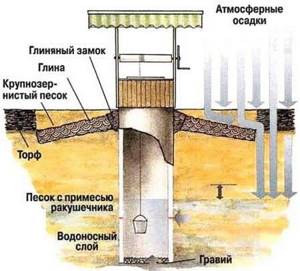
How does a clay castle for a well work?
Clay well area
To drain surface water from the well, it is also recommended to make a blind area. In its simplest form, it can be built from clay. Taking into account the possibility of heaving, its thickness should be 10-50 cm. It is not worth making the blind area thicker, since in this case it approaches the design of a clay castle, and problems associated with it arise.
A significant disadvantage of a clay blind area is the need to organize a protective coating over it. The fact is that the clay itself, when wet, turns into “mud”, which is unpleasant to walk on. This increases the labor intensity and cost of building such a blind area.
Despite this, I still decided to make a clay blind area around my well. And to reduce heaving forces, additionally insulate the soil around the well.
The soil on our site is clayey. The fertile layer goes to a depth of 40-50 cm, and clay begins below. So I decided to select a layer of soil around the well at a distance of about a meter and fill the pit with clay. Luckily there was enough of it - next to the well there was a pile of clay taken out by the workers when digging the well. The quality of the clay suited me quite well. And there was an opportunity to partially recycle it.
When the soil layer and what the workers called the “lock” were removed, a fairly wide gap opened between the soil and the rings. It became clear that the urgent recommendation for those who are going to make a castle or other protective structures around the well is to begin this work in 1-3 years, when the soil around the rings is compacted. The Internet is replete with photographs of failed blind areas around wells, which is the result of their premature construction.
But it was not my plan to wait that long. I decided to speed up the process of silting up the gap somewhat by trying to fill it with clay. This had to be done in several stages. I placed the clay all the way to the top in the slot and compacted it. But the next day it was discovered that water had filled the pit, and the clay had settled down, and the gap opened again.
To continue the work, I pumped water out of the well (about two rings), as a result it also left the crack. And again and again I put clay in it to the top and compacted it, the water filled the pit, and the clay settled. I did this several times. At some point, the clay stopped settling - the gap remained filled for several days.
For reliability, I decided to add liquid glass to the top layer of clay filling the gap. Having made holes in it with a shovel handle about a meter deep, poured liquid glass into them and tamped the clay with it again.
After this, he began filling the pit around the well with clay. I did this in small layers, compacting them and forming a slight slope away from the well.
The correct clay castle for a well made of concrete rings on vodatyt.ru
After the well is dug, so that the walls do not burst, it is necessary to carry out the arrangement. Craftsmen recommend using a clay castle for a well made of concrete rings. This technology is popular due to the high degree of protection of reinforced concrete structures in the ground.
Features of waterproofing with a soft blind area
The use of temporary waterproofing in a soft blind area around a well has a number of technological aspects that must be taken into account during the installation process:
- The entire structure is laid at the level of the second ring.
- The materials used are waterproofing film and sand.
- The edges of the film strips are thrown over the well rings.
- Decorative material is laid on top of the film and sand.
In this case, all technological requirements must be met.
Laying technology
Before making a clay castle, you need to dig up the soil to the level of the 2nd ring. The selected soil is no longer used and must be removed and disposed of. A film is placed on the bottom. The size of the area to be closed is at least a meter from the outer wall of the reinforced concrete ring.
One end of the film is placed over the well above the seam. It needs to be secured, for which a metal belt, tape or self-tapping screws are used, which are screwed directly into the concrete. In the case where adhesive tape is used, several turns must be wound. After this, the cavity is filled with sand on top of the film.
Backfilling is not carried out to the very top if FEM or natural rubble stone is used as a decorative coating. When laying, check that there is a slope away from the well of at least 1.0-1.5 degrees. But this is a temporary method, and to ensure the tightness of the well, a clay castle is a necessity. But not every type of clay can be used as a material.
How to lay a soft blind area around a well + video
Some “experts” argue that this type of protection against water pollution is an atavism and a relic of the past. In fact, such statements are justified by two tricks:
- Few people say that you need to wait two years and then start improving the well. This is in order to put the source into operation as early as possible.
- It is beneficial for them that the client contacts them every year. After all, as a rule, the same people are engaged in cleaning wells from dirt, and it is beneficial for them that garbage appears in the water as early as possible.
The technology involves laying a film that covers the soil a meter around the walls of the well. The overlap that is placed over the seam between the first and second ring should cover it. The cavity obtained after excavation of the soil is filled with clay. It cannot simply be filled in and compacted mechanically. It is better to see the installation technology.
Disadvantages of a clay castle
The poor quality of the work performed is due to the fact that people who decided to lay the clay castle themselves do not adhere to the technology.
If the clay is not matured enough, is not mixed correctly, is dry or uneven, it is impossible to achieve the desired plasticity. People do the backfill as is and simply compact it with a mechanical tamper.
As a result, the perched water, which lies in the upper layers of the soil, freezes in winter. The resulting ice, when expanding, puts excess pressure on the rings and seam and leads to a violation of the integrity of the structure. Another drawback is the two-year wait for natural soil settlement. But this problem can be solved with a temporary castle made of compacted sand.
Conclusion + useful video
Summarizing all of the above, we determine that all the work associated with the installation of a clay castle can be done independently. Teams that claim that this is not necessary cannot be considered professional, or are being cunning in front of the customer. The described procedure is one of the mandatory measures for the improvement of natural drinking water sources.
The only thing that needs to be taken into account is that the clay castle is installed two years after the well is put into operation.
This means that in some cases decoration will have to be postponed. And within a two-year period, sand will be installed instead of clay. Otherwise, there are no difficulties, and the water in the well will remain clean and clear for years.
The correct technology for compacting earth
Subsequence:
- The entire fertile layer of soil is removed (to the depth level of the second ring).
- The film is laid out so that one edge covers the ground near the wall (more than a meter), and the second is placed on the ring itself, covering the seam between the second and first ring.
- The film must be pressed against the well so that it does not slip. To do this, cut out a metal tape and wrap it around the wall of the first ring, pressing down the film. Fixed directly to the concrete with screws.
- You can simplify the task: secure it with tape by wrapping it around the ring several times. However, in the second case, you need to hide the pasting area under decorative material.
- A sand cushion is poured on top of the film with a slope away from the well and a decorative coating is laid out.
With this method, no heaving of the soil will tear the seam, because it is covered with a dense, loosely fitting film that can adapt to soil movements.
There is a certain technology:
- To create a castle, you need to use a material that has natural moisture. When it is extracted from the earth cover for future storage, the material should be soaked in water and then covered with something. In order to check the quality of the created material, try to mold something from this clay. If the quality is poor, then the clay should crumble in your hands. The material should slide off your hands. All this will help you understand whether the material is ready to start using. Since clay contains a huge amount of sand, twenty percent lime can be added to it.
- You can achieve the best results when compacting the material in an auxiliary structure (formworks). To install the formwork you will need wooden panels. It must be installed so that the thickness of our clay castle is two hundred millimeters. Tamping should take place in layers, the height of which should be on average 250 millimeters.
- Geotextiles need to be placed on the outside of the clay castle. This canvas will prevent erosion of the structure by groundwater.
- The process of making a clay castle is reminiscent of the process of creating a blind area for a building. The width of a clay castle can be different, it starts from one meter, the depth starts from 50 centimeters. The best thing is that all these indicators were greater. The clay is covered with a geotextile fabric, and you can put cobblestones on the fabric.
As you understand, clay is a suitable material that can be used to isolate a well from underground moisture. The cost of clay as a material is low, and maybe even non-existent, since the clay is right under your feet. Any procedure that involves clay can be performed independently. This work does not require any specific skills or effort. But at the same time, the work is quite labor-intensive.
This procedure must be carried out in several approaches, as soon as you have laid two hundred millimeters. If a poor-quality seal is made, then the whole process must be done all over again. The clay used for the clay castle should have a moisture content of 20-30 percent.
Otherwise, cracks and crevices will appear in the ground, and the clay castle in this case will be useless. This work can be done with your own hands or with someone else. It is best to entrust the work to specialists.
When installing a clay castle with your own hands, it is important to strictly follow the technology, then the water in the well will not be polluted, and the seams of the structure will not be deformed. The work is carried out in 2 stages:
The work is carried out in 2 stages:
- First, the top ring of the well is sprinkled with dense clay and compacted. There is no point in stopping after completing the first stage, because this is a temporary measure that is not effective and will not be able to protect the well in winter.
- The second stage is making a real castle, for which we use fatty clay, which can be obtained by digging the soil 3 meters deep.
Around the well, the top of the shaft is dug in the clay, slightly deeper than the second seam from the surface of the soil. The shaft of the mine is wrapped with roofing felt, and the resulting space is filled with clay. In this case, backfilling should be done 30 centimeters above the soil level.
The castle is ready! It will not allow top and melt water to penetrate into the well, and the seams will not be deformed. The use of roofing felt will provide protection against heaving soils. After completing the installation of the lock, the well should be thoroughly cleaned.
What it is
A clay well lock is a layer of compacted clay that is placed along the concrete rings of a water shaft to prevent rain or waste water from entering. It is actually a water seal.
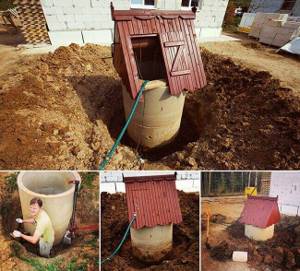
Advantages and disadvantages
The advantages include:
- Reliable and effective waterproofing material. It is not for nothing that at the depth where the clay layer lies, there is practically no groundwater.
- Very low cost.
- You can build it yourself.
- Simplicity of design.
- If constructed correctly, the structure will last a long time; it will not have to be repaired or maintained.
However, there are some disadvantages:
- The installation process is quite labor-intensive and long.
- Not every clay is suitable for the shutter.
- If it has not dried properly, then during frosts it will swell and cracks will form.
- If compacted poorly, the material tends to shrink, which will lead to the formation of a hole around the shaft.
When and why do you need such a device?
A clay castle around the well is needed if there is a risk of swampiness or an abundance of perched water on the land plot in the spring and autumn.

To prevent the aquifer from concrete rings from becoming clogged with soil and debris carried by rain, as well as the upper layers of groundwater, it is not enough to hermetically seal the seams between the rings. It is necessary to provide additional waterproofing.
How to do it yourself?
All types of protective structures - soft and hard - are built according to the same algorithm:
- Pause period per year.
- Cleaning the workspace.
- Digging a trench around the perimeter.
- Equipment for pillows made of bulk materials.
In this case, any blind area is arranged at an angle of 2-5 degrees for hard, 5-10 degrees for soft.
Soft
Excavation is carried out to a width of up to 1.5 m on all sides around the mine; it is advisable to select the entire fertile layer and reach the parent rock. The bottom is carefully compacted and sprinkled with fine sand.
The finished trench is overlapped and folded (without allowing tension) to be covered with the selected material for waterproofing; the angle of the film should reach the upper ring of the well. The ends of the film are secured with construction adhesive tape or metal staples; it is also possible to use screws. The folds in the film are designed to smooth out the processes of soil displacement.
Construction sand is laid on top of the insulating layer for better drainage, followed by paving stones (it is possible to use paving slabs, crushed stone, large river pebbles or other decorative materials), sometimes, at the request of the site owners, a lawn is sown.
solid
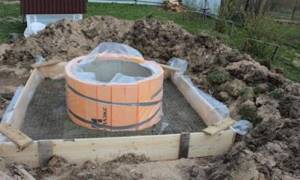
A herbicide is poured onto the bottom of a trench up to one meter wide to prevent grass growth, followed by a 15-centimeter layer of sand cushion, then 10 cm of crushed stone. All materials are subject to enhanced compaction. If you plan to operate the well for a long time, it is advisable to reinforce it with a metal mesh.
A layer of waterproofing is attached to the outer walls of the well shaft (where there will be contact with concrete), this is done to prevent the solution from attaching to the walls of the well and their further cracking.
Wooden slats, lubricated with bitumen resin, are laid out in a circle around the well at regular intervals; they are needed to level the concrete being poured.
The laid concrete mixture is carefully leveled and the surface is sprinkled with fine cement dust (smoothed with a construction trowel), and so on several times. The completed blind area is kept for about a week in a constantly damp state (it is supported with a soaked rag).
Like other types of blind areas, concrete protection is also placed on a slope for water drainage, sometimes even drainage channels are laid.
What is a blind area: what types are there?
After installing the water seal, the issue of draining storm water from the mine shaft remains open.
A blind area is a structure around a well, equipped with a slope from the ring to the side. It comes in hard and soft material.
- special waterproofing film;
- bikrost, roofing felt;
- high density polyethylene film.
Pros and cons of soft and hard
There is a fundamental difference between soft and hard. The second one looks like a slab, the first one, on the contrary, is not visible at all.
Concrete and clay have a structure that can swell when frozen.
Soft, on the contrary, does not deform.
Also, when the earth shrinks around the well, the solid blind area will not sag, and a gap will form between the concrete and the ground, which will not be immediately visible. Over time, water and soil will get into it. If a ring gets into the barrel, it can ruin the quality of the water.
Soft, natural shrinkage of the soil will immediately show where this is happening, so you can take timely measures to correct the situation.
How to make a solid blind area: instructions

It is made on a clay base and sprinkled with sand.
- To do this, dig a trench 1.5-2.5 meters wide and 20-30 centimeters deep along the entire circumference of the ring.
- Add sand and fine gravel to the bottom of the hole.
- If there is already a gate at the base, then the concrete can be laid directly on the compacted clay.
- Before pouring the blind area, the rings are treated with bitumen or PVC film. It is also recommended to place reinforced mesh in the concrete to strengthen the slab.
Important: for the installation of a concrete blind area, it is best to use grades of concrete with a high cement content, for example, grades 200, 300. You can also add the elastic additive “Penetron”.
How to make a soft blind area step by step
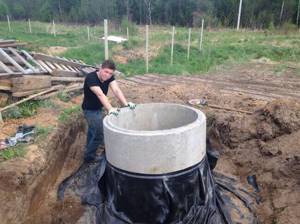
It all starts with digging a trench around the well. The sizes are the same, but professionals recommend increasing the size by 20-30 centimeters. The depth of the trench is 10-15 centimeters.
The waterproofing material is laid on compacted soil or a cushion of ASG, starting at the edges of the ring. The overlap should be at least 15 cm. The waterproofing can be secured with a metal rim and by heating with a propane torch (simply glue the material to the concrete). Then the film is spread along the entire length of the trench and the ends are secured in the ground, simply sprinkled with crushed stone.
Coarse gravel or crushed stone, as well as sand, are poured on top of the material. They fall asleep completely, so that only the embankment is visible above the ground.
Now you can sprinkle black soil on the gravel and plant lawn grass. This method will fit perfectly into the green landscape of the site.
Tips for use
- It is not advisable to equip them immediately after installing the well. It is better to let the soil settle for a year or more.
- When installing a soft blind area, it is better to use special waterproofing films.
- It is better to make a castle and blind area in late spring, when there are no longer frosts and the soil is still filled with water. In addition, during the spring and summer it will be clear whether the work was carried out correctly and whether it copes with water.
- The slope angle for a solid blind area is 2-5 degrees. For soft - 5-10.
- To install a concrete blind area, it is better to assemble wooden or metal formwork, and not just pour raw materials into a dug ditch. This will help give shape and neatness to the final product.
- After arranging the concrete blind area, you can build any decorative structure on the surface, for example, a gazebo with a roof.
Conclusion + useful video
Summarizing all of the above, we determine that all the work associated with the installation of a clay castle can be done independently. Teams that claim that this is not necessary cannot be considered professional, or are being cunning in front of the customer. The described procedure is one of the mandatory measures for the improvement of natural drinking water sources.
The only thing that needs to be taken into account is that the clay castle is installed two years after the well is put into operation.
This means that in some cases decoration will have to be postponed. And within a two-year period, sand will be installed instead of clay. Otherwise, there are no difficulties, and the water in the well will remain clean and clear for years.
The process of creating a clay castle
Since the foundation is the foundation of the house, it must be completely isolated from the influence of groundwater and rainwater. The structure of the clay castle and its width depend on the depth of the house’s foundation in the ground. If the depth of the foundation is two meters, then the width at the bottom of the clay castle is 40-50 centimeters, and at the top – 25-30 centimeters. It is not very common to install a clay castle around the foundation.

Before starting the entire installation, a pit of the required width is dug. Crumpled clay should be placed in layers in the pit.
If you did not have time to do all the work in just one day, then the entire structure must be covered with a membrane that will protect the structure from moisture. In order to make a waterproof coating around the building, you need to wait about half a month after building the clay castle.
In order to provide complete protection from any moisture, a waterproofing membrane can be placed between our structure and the base of the house.
Why do you need a clay castle?
The construction of a well cannot be done without installing a clay castle, which tightly envelops the structure and makes it waterproof. Clay retains water well, which means it is an ideal option for waterproofing. The castle performs important functions, namely:
- protects the well from water ingress from the ground;
- provides protection for adhesive waterproofing: a clay lock prevents water flows from entering the rolled materials, and therefore increases their service life.

Safety Basics
Inexperienced homeowners often neglect basic rules and endanger not only themselves, but also their partners. To avoid ridiculous injuries, you need to follow at least some basic rules.
- A person in a mine must protect his head with a helmet. Anything can happen; a bucket falling down or a tool falling down is not uncommon.
- Ropes, ropes, ropes, rings - everything related to lifting is carefully checked before starting work.
- A person dripping in a shaft must be secured with a rope, and if the depth of the well is over 6 m, then with two: a working rope and a safety rope.
The construction of a well must be carried out by several people
There are so-called gas pockets in the soil, and since the air exchange in the mine is not fast, as you descend, they periodically light a candle. Its flame should burn evenly, which indicates a sufficient amount of oxygen; if the fire goes out, the pit needs to be checked.
Advice! There are several ways to ventilate a mine. The easiest way to do this is with a thick blanket, which is lowered to the bottom several times and raised back on ropes. A fan lowered to the bottom of the shaft will also help speed up gas exchange.
What clay is suitable
Not every one is suitable for the shutter. You need to select raw materials according to several parameters:
- It must be very fat.
- It cannot contain sand or lime.
- Looks like plasticine.
- If you rub it, there will be no grains of sand on your palms. The piece will remain a single mass.
The best way to check the composition of the raw material is to mold it into a ball and leave it in the sun to dry. The oily one will crack and become tough. The ball containing sand and impurities will remain unchanged, and grains of sand will shine on its surface.
How to improve
- Soak in water for several days. This measure will allow it to gain a sufficient amount of moisture and become more pliable for work.
- Soak in water, but leave it outside for the whole winter. After it sits in the cold and then thaws, the clay will become like real plasticine.
- Add slaked lime to the raw clay in a ratio of 20% to 100%.
Performing a blind area
When the clay castle is ready, start creating the blind area. Why is it needed? The fact is that after heavy rains or melting of large volumes of snow, even the most compacted castle can begin to become limp - its top layer will either get wet, turning into mud, or dry out in lumps. This will gradually lead to depressurization of the protective structure. Some well owners do not want to bother with the blind area and simply cover the clay castle with a backfill of crushed stone and sand, but, as practice shows, this is not always enough. So, if you are interested in the durability of a clay castle, you cannot do without a blind area.
It is recommended to use either paving slabs or stone as a coating - these materials are quite strong and durable. The technology for performing the blind area is quite simple:
- Cover the clay castle with geotextiles or any other insulating material with similar functional properties.
- Place the selected finishing material on the insulating screed. Be sure to make a slight slope to ensure the removal of excess moisture from the area of the well and the castle.
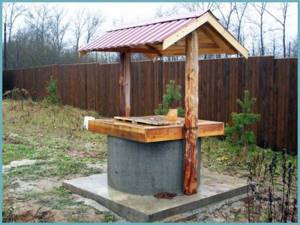
If you want to make the blind area even more reliable, you can do the following: after laying the insulating material, install low formwork on it, and then fill the clay castle with concrete mortar - after it dries, lay tiles or stone.
As you can see, a clay castle has every reason to claim the title of one of the most effective protection options for wells. If done correctly, it will successfully cope with its functions for many years, so if you want to get a high-quality design, follow proven technology and do not deviate from the rules - this is the only way you will ensure reliable protection for your water source.
Procedure for carrying out work
If there is no opportunity or desire to use the services of a team of professional builders, all that remains is to make a clay castle for.
- Digging in. A trench is dug along the perimeter of the well to a depth of 150 - 180 cm. As a result, the second seam of the ring connection should be visible.
- All connections must be protected from clay getting into them. Any hydrophobic material that does not rot or decompose will do, for example, polyethylene film.
- Preparation of material. For a clay castle, it is allowed to take clay with a sand content of up to 15%, but the lower the figure, the better. If you follow all the recommendations, the clay is aged before use (usually left for the winter). To add strength to the castle, lime is mixed into the solution so that its content does not exceed 20% of the total mass of the mixture. The more sand there is in the clay, the more lime you need to add.
It is important that the clay is kneaded and not mixed. Previously, this operation was performed with feet, today they use small concrete mixers or use a drill with an attachment
The next step is to create a blind area on top of the castle. And without the recommendations of SanPiN, it is clear that after rains or melting snow, even a tightly compacted clay castle will turn into mud. The “soggy” top layer will get wet and dry, which will gradually lead to a loss of tightness. Therefore, the construction of a blind area is considered the logical completion of the process of creating a protective castle.
The covering material is selected based on personal preferences; both stone and paving slabs are suitable. And the creation technology does not seem complicated:
- the castle is covered with geotextile or other material with similar properties,
- The selected material is laid on top of the screed.
You can assemble a low formwork and fill the castle with cement mortar on top. The main thing is that the slope is maintained, because the task of the pavement is not just protection from moisture, but also its removal.
The construction of a clay castle will not affect the bacterial and chemical composition of the water on the site, but it will help keep it clear and suitable for consumption, if it was so initially. Therefore, in solving the dilemma “for” or “against” clay castles around the well, it is worth tipping the scales towards a positive answer.
How to make a solution
To prepare the solution, you must maintain the proportion: 1 part cement, 3 parts clean sand and 4 parts crushed stone. The crushed stone to be used must be small. Less is better. The solution is mixed in a special trough or in a concrete mixer. First, mix cement with sand and gradually add a little water. The denser the solution, the better the quality of the rings.
To prepare the solution you will need cement, crushed stone and sand.
Make sure the edges of the ring are even. The formwork can be dismantled after 10 days. The ring has not yet hardened completely, so you need to be extremely careful with it. It is placed on 2 rails or other parallel strong boards and left for another 10 days.
Advantages and disadvantages
The advantage of a clay castle is the low cost of its arrangement. During installation, predominantly natural materials are used - clay, a small amount of sand, pebbles. Another advantage of such a waterproofing structure is durability.
The disadvantage is the complexity of arranging the castle. The soil must be laid in thin layers and compacted thoroughly. You should use high quality material, free of impurities, but it can be difficult to find clay with the required characteristics in nature or to purchase it.
Disadvantages and advantages of clay castles for wells.
How to arrange a soft blind area?
Construction of the blind area begins after the installation of the rings is completed.
To form it you will need the following consumables:
- Sand – 2-3 cubic meters. It can be obtained while digging a well shaft.
- Polyethylene film or polymer coating for waterproofing swimming pools 150 centimeters wide and up to 500 cm long.
- Metal tape – width 5 cm, length 300-350 cm.
- Self-tapping screws and dowels.
Soft sand blind area
The process of forming the blind area itself is as follows:
- Remove the layer of soil around the top ring. The width of the pit is up to 1.5 meters. Depth – to the level of the junction of the first and second rings.
- We lay out the plastic film along the bottom of the trench, raising the edge closest to the well above the level of the junction of the first and second rings (the overlap is 10-15 centimeters).
- We fix the film to the well using steel tape, forming a belt. We fasten the tape with self-tapping screws and dowels.
- We fill the trench with sand.
- We create decorative finishing. In this case, it is best to use gravel or paving slabs laid at an angle from the well to the edge of the trench.
As you can see: nothing complicated. Moreover, the quality of insulation in this case is much higher than when arranging a clay castle.
Groundwater repair and restoration
Sometimes, if installed incorrectly, as a result of long-term use, the valve becomes unusable, and dirty water begins to penetrate into the shaft.
If during the inspection it turns out that the water seal is not working, then it can be repaired. When the upper part of the lock has peeled off and a gap has appeared between the clay and the ring, as well as in the ground, it means that the well has shrunk, and you can get by with repairing the upper part. To do this, you need to dig out and remove the clay to a compacted area. Compact the layer again and add the required amount again. For repairs, it is better to use new clay, fatter than before.
If it is clear in the shaft that groundwater is flowing through the butt joints, then the entire castle must be repaired. Here you will have to do everything again. Completely remove the clay from the trench and fill it with new clay. Of course, you can try to use the old one, but in this case it needs to be thoroughly processed (soaked in water, mixed with slaked lime).
Clay castle: what is it, how to make it and why
One of the final stages of creating a well is backfilling and compacting the soil around the top of the shaft. Often customers demand, and well builders, accordingly, offer the construction of a clay castle.
Clay castle around the well trunk. Photo from the site kolodecgrad.ru
However, this element does not always function correctly and is generally necessary. Often, on the contrary, a clay castle causes harm.
What is a clay castle
A clay castle is a waterproofing structure made of clay of a certain quality around foundations, wells, cellars, pools, installed where it is necessary to limit the flow of water. The characteristics of such structures were regulated by Building Codes and Regulations (for example, SNiP II-53-73 “Dams made of soil materials” is no longer valid).
Clay serves as a waterproofing agent because it consists of small particles (less than 0.002 mm in size) that are shaped like flakes, like fish scales or lentils. The pores between the clay particles are also small, their size is about 0.005 mm.
Clay
When moistened, clay particles swell and block access to water; more precisely, water passes through the clay, but very slowly. And if it has another path, then the water will choose it instead of the extremely leisurely seepage through the clay.
How does a proper clay castle work?
The structural features of clay (small flat particles-flakes) determine the functioning of a clay castle. SanPiN 2.1.4.1175-02 “Hygienic requirements for the quality of water from non-centralized water supply. Sanitary Protection of Sources” (replacing SanPiN 2.1.4.544-96) recommends its installation during the construction of wells. In particular, paragraph 3.3.4 of this document states: “A castle should be made along the perimeter of the well head from well-pressed and thoroughly compacted clay or rich loam 2 meters deep and 1 meter wide.”
Construction of a well and a clay castle. Photo from the site kolodec.ru
If you are planning to build a clay castle, pay attention to these recommendations - depth and width. And the most important thing is that you need to use clay or fatty loam, that is, rocks containing more than half of the clay particles or at least 40% (fat loam)
And not just loam or even sandy loam, where there are no more than 10% clay particles.
The clay for the castle must be well kneaded - only then will it become waterproof. Photo from the site iz-kirpicha.su
It is also important that the clay is well kneaded and then thoroughly compacted. When the clay is crushed, its flat particles occupy a position parallel to each other: the “lentils” are tightly nested into one another
At the same time, the pores of the soil decrease, and the clay stops allowing water to pass through - it becomes a clay castle.
Why does a well need a clay castle and is it needed at all?
Why does a well need a clay castle? In order to prevent water from flowing down the outer wall, seeping through the seams, and, ultimately, moisture that has not been treated enters the well.
As stated above, clay waterproofing will only work if the clay is properly prepared and installed. Therefore, simply some kind of clay mixture, poured and even compacted when laying with feet or hand tools, will not provide a waterproofing effect. But it will be perfectly susceptible to frost heaving - an increase in the volume of soil when water freezes in its pores. This is especially true for clay soils.
How harmful is the “wrong” clay castle. Photo from the site kolodec.ru
In winter, the clay around the rings expands. And since it cannot expand in the horizontal direction, it does so vertically - along the shaft of the mine, while tearing off the upper rings. Cavities form under the clay layer: the soil around the rings continues to shrink for several years, and the castle has a different density and structure. Water and all kinds of debris, including the corpses of dead small animals, get into the resulting cavities.
An improperly constructed clay lock does not prevent untreated surface water from entering the well, but further aggravates this process. Therefore, if you are not sure that the waterproofing layer of clay will be laid correctly, it is better not to create unnecessary problems for yourself.
Where to put the clay after digging a well: castle equipment
Sanitary rules and regulations give a precise definition of a clay castle. This is a structure that serves as a formwork for a well, the width of which is 1 m and the depth of 2 m. The clay must be compacted tightly. At the same time, the material for arranging a blind area is not suitable for everyone. Clay and fatty loam must be kneaded well. Sand, gravel, and sandy loam cannot be used for the castle. The permissible amount of sand in a clay castle is 5-15%.
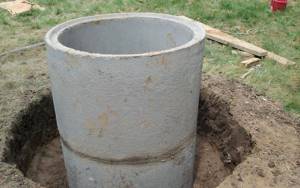
Discussions constantly arise around the issue of the need to equip a blind area. Sanitary standards say that the clay castle should be in combination with other blind areas. They create a ring with a radius of 2 m. A distance of 10 cm should be taken from the walls of the well.
Additional devices for the clay castle:
- Stone;
- Concrete;
- Brick;
- Asphalt.
Before installing a blind area, the well must stand for at least 1 year. During this time, natural shrinkage of the soil takes place. This way, voids and weak areas will not arise in the future.
The soft blind area performs not only an aesthetic function. It will protect the lock from defects during use.
Water may subsequently accumulate in uncompacted areas. Ground dwellers and rodents fall into such traps and die. This can result in decomposition products getting into drinking water. The duration of shrinkage is determined by the type of soil.
There is no need to rush to install a waterproof lock before installing the water supply. After this, additional waterproofing should be done. For land prone to seasonal heaving, a clay ring cannot be installed.
When to do a blind area and whether to do it at all
Let's start with the question - why do we need a blind area? Mainly to prevent contaminated high water and melt water from seeping into the groundwater well from the surface of the earth. Her task is not to let them through to the mine shaft, to take them aside. One should not neglect the fact that a well with a blind area looks more aesthetically pleasing, and it is much more convenient to use it standing on a clean and dry foundation. However, the need for it may not arise if the following conditions are present:
- The well is located away from roads, industrial zones, in an environmentally friendly place;
- It stands on a hill, which prevents the flow of surface water to it;
- Equipped with automatic water-lifting equipment that does not require your frequent presence at the well.
Now about the best time to make a blind area. The instructions state that no earlier than a year after completion of construction, since during this time (and sometimes longer) self-compaction and settlement of the soil filled around the well shaft occurs, as a result of which voids and failures are formed.
Sinkholes around the new well
Also during this period, there may be a natural displacement of the upper rings of the well in the horizontal plane, which can also disrupt the integrity of the blind area. Therefore, its construction can be started only after these processes have been completed and their consequences have been eliminated.
Types of blind areas
The blind area at the well can be made of different materials: clay, concrete, reinforced concrete, as well as waterproofing film and sand. The latter is called a soft blind area. Let's look at the features of their device.
Solid types of blind areas
Made of clay or concrete with a thickness of 20-30 cm and a width of 1.2 to 2.5 meters along the entire perimeter of the structure:
The clay blind area is a layer of compacted clay placed in a recess of the specified dimensions. Its main disadvantage is the formation of slippery and sticky dirt on the surface when water gets on it. This will require additional costs for the installation of a protective coating.
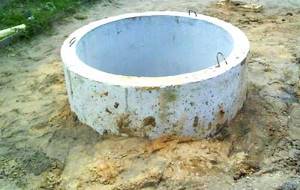
Clay blind area
The concrete blind area of a well is made by pouring concrete into the formwork installed in the recess on a bed of gravel. To make it last longer, reinforcing mesh is placed in the formwork before pouring the solution. A prerequisite for the manufacture of such a blind area is waterproofing the outer walls of the well in the place where they will come into contact with the concrete. This is necessary to prevent rigid adhesion of the well ring to the frozen blind area slab.
Scheme of the concrete blind area
The disadvantage of this type is the frequent formation of chips and cracks on the surface. They not only allow surface water to pass through, but also give the concrete surface an unkempt appearance. However, this is not the biggest problem - if desired, the blind area for the well can be repaired. But it itself, if the manufacturing technology is not followed, can damage the well trunk and compromise its integrity. The fact is that the blind area is affected by the forces of frost heaving, and if it is rigidly connected to the upper ring of the well, it may be separated from the lower one. As a result, a gap is formed between them, through which contaminated water and soil particles fall directly into the mine with clean water.
The photo shows dirty streaks from the gap between the rings
Soft blind area
This structure consists of a waterproofing film, which is covered with a layer of sand. It is possible to install a decorative covering or lawn on top. Its production does not require large financial and physical costs and consists of the following steps:
- Before making a blind area around the well, fertile soil is removed around it to a width of 1.2-1.5 meters;
- A waterproofing film is placed at the bottom of the recess, the edge of which is placed on the upper ring;
- The film is fixed to the ring using double-sided tape or a metal strip, through which it is attached to the walls with dowels or screws;
- At the point where the film transitions from a vertical to a horizontal position, a fold must be made. It is designed to compensate for displacement and subsidence of the soil in the base, which will prevent damage and destruction of the top decorative layer;
- Sand is poured onto the film, on top of which paving slabs, paving stones, bricks, crushed stone, etc. are laid. You can simply put back the previously removed turf or sow lawn grass.

Scheme of a soft blind area
Advantages of a soft blind area
In addition to the fact that manufacturing such a design in an economical version will require a minimum of effort, it has many other advantages:
The most important thing is that there is no risk of the well shaft rupturing along the seam between the rings; The soil around the well can settle and compact without damage to both the well itself and the covering of the blind area; Low price of materials used; If it is necessary to repair the well, the soft blind area can be easily dismantled; A waterproofing film will do a much better job of draining water from the walls of a well than clay or concrete; Low labor intensity of the process - in this case, digging a well with your own hands is done without problems and without the involvement of assistants; Decent service life, reaching 80 years. Only the outer decorative layer may need repairs; Finally, you can use any decorative finish from wood decking to stone cladding.
Blind area options
- Fill the clay castle with sand and gravel
. - Turf.
Layers of turf can be used as a blind area, but a prerequisite is the organization of a drainage system. - Tile.
Tiles are laid on top of the clay castle along the house. Having previously filled the base layer. - Concrete blind areas.
They are more expensive than the previous one and after a few years they will begin to let moisture through, even with additional reinforcement. Consequently, it will require replacement and additional costs.
To protect the foundation from destruction by groundwater and wastewater, you should organize a drainage system, build a clay castle and cover it with a blind area on top. If additional financial resources are available, it is possible to use additional waterproofing materials.
Foundations and walls of basements require mandatory waterproofing. Today there is a huge range of rolled and coating materials on the market, but once upon a time clay was traditionally used to protect the underground parts of structures from moisture penetration. Modern builders have not forgotten about clay castles built around the foundation, so the technology is still used to this day. But here we should not talk only about the Russian outback, since clay waterproofing is also popular in some European countries. The naturalness and high moisture resistance of the material ensure a fairly high demand for it, especially since the quality of clay castles has long been time-tested.
